Washington State, renowned for its majestic landscapes ranging from the rugged Pacific coastline to the lush, dense forests of the Cascade Range, offers a diverse array of natural wonders. Among these, Washington hot springs stand out as serene retreats that beckon with the promise of relaxation and rejuvenation. Nestled in various corners of this picturesque state, these thermal waters are not just natural phenomena; they are storied places that offer a unique blend of leisure, health benefits, and connection to the natural world.
When visiting Washington hot springs, it’s crucial to act responsibly and care for these environments, ensuring they remain safe, clean, open, and welcoming for future visitors! Please find the best spots to unwind and visit with our curated selection of Washington hot springs.
10 Popular Hot Springs in Washington
Here’s our list of the top 10 must-visit Washington hot springs.
1. Goldmyer Hot Springs
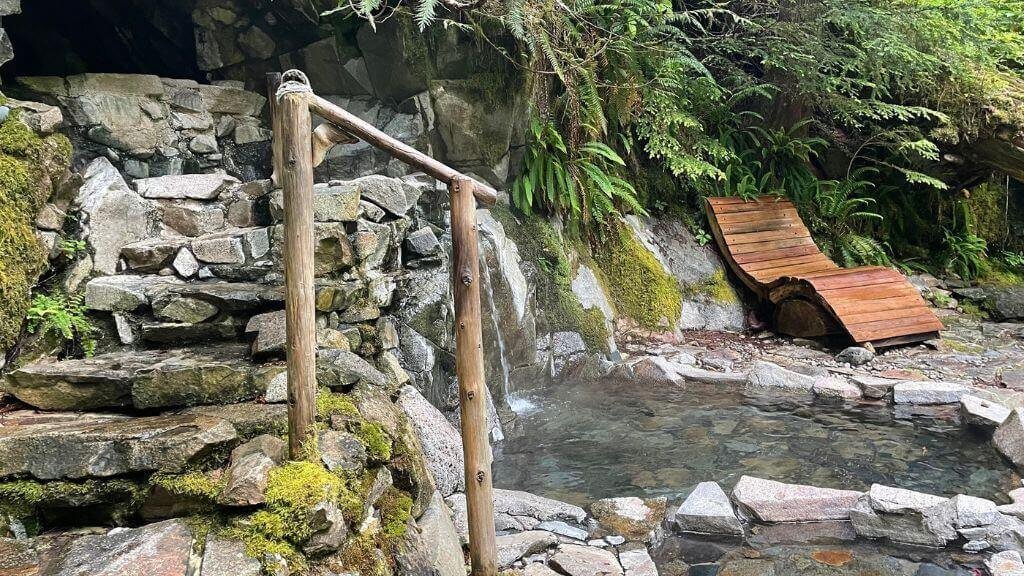
Tucked away in the heart of the Cascade Mountains, Goldmyer Hot Springs is a gem that requires some effort to reach. Accessible via a 4.5-mile hike through the lush wilderness of the Snoqualmie National Forest, the journey to Goldmyer is as rewarding as the destination itself. The trail meanders through ancient forests and alongside serene creeks, setting the stage for the tranquil experience that awaits.
Goldmyer Hot Springs features a series of pools cascading from a cave source, offering varying temperatures that cater to all preferences. The surrounding old-growth forest provides a canopy of privacy and serenity, making it an ideal retreat for those seeking solitude and connection with nature.
2. Sol Duc Hot Springs
Situated in the Olympic National Park, Sol Duc Hot Springs is accessible by car, making it a convenient escape into nature. The area is steeped in legend and lore, with the indigenous peoples of the Olympic Peninsula having utilized these waters for centuries for their healing properties. European settlers recognized its potential early on, developing it into a resort that has evolved over time but always with reverence for its natural and cultural significance.
Today, Sol Duc Hot Springs Resort offers visitors a blend of rustic charm and modern amenities. With three mineral hot pools and one freshwater pool, the resort caters to all ages and preferences. The resort is enveloped by the dense forests of the Olympic National Park, providing a backdrop of towering trees and the melodious sounds of the Sol Duc River. It’s a place where luxury meets wilderness, offering a unique opportunity to indulge in the healing powers of nature without forgoing comfort.
3. Olympic Hot Springs
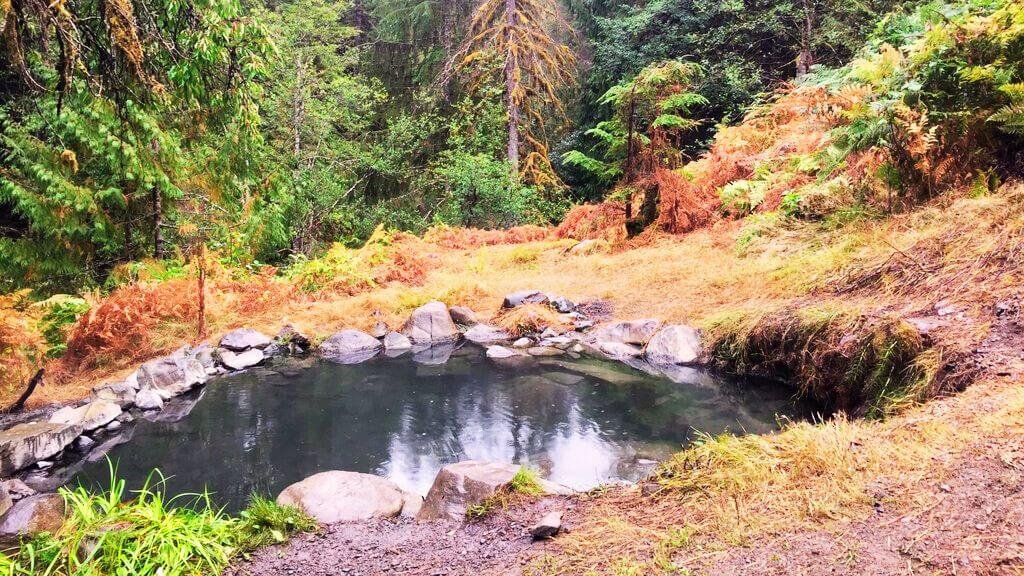
Olympic Hot Springs is a serene hot spring pool located within the captivating confines of Olympic National Park, offering a secluded and tranquil retreat. Encircled by natural rock formations, the pool provides a private haven for those looking to disconnect and find peace in nature.
Historically, the area was home to the “Hot Springs Hotel” from the late 19th to the early 20th century, complete with bathhouses and lodgings for visitors drawn to the healing properties of the springs. After the resort’s closure and subsequent demolition, the remaining natural pools continued to offer a unique wilderness experience for visitors of Olympic National Park.
The source of the spring boasts temperatures around 130°F, with the water cooling as it flows down the terrain to fill the turquoise pool, accommodating around five to six bathers. Access to this hidden gem involves a 2.5-mile hike starting from the Appleton Pass Trailhead, inviting adventurers to immerse themselves in the natural beauty and soothing waters of the spring.
Read More: Blue Heart Springs
4. Gamma Hot Springs
Gamma Hot Springs stands out as Washington state’s most elusive and remote hot spring destination, presenting a formidable challenge not recommended for novice wilderness explorers. Nestled within the daunting terrains of the Glacier Peak Wilderness, the springs are shrouded in an almost legendary aura. The journey to Gamma Hot Springs demands seasoned backcountry skills and proper gear, with success in locating these hidden gems far from guaranteed.
Those who manage to navigate the journey are often rewarded with solitude, as Gamma Hot Springs remains a largely undiscovered treasure. The expedition requires adept navigation skills and preparedness to face the wild without the comfort of amenities.
5. Doe Bay Resort & Retreat
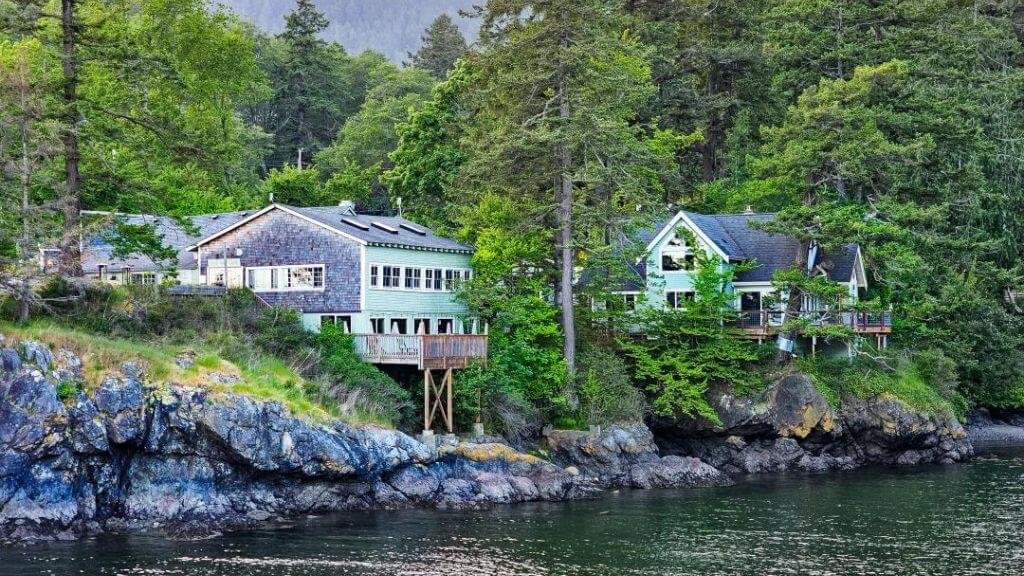
Doe Bay Resort & Retreat, set on the picturesque San Juan Islands near Moran State Park, offers a quaint and eco-conscious hot spring experience. This resort is celebrated for its three saltwater hot tubs fed by natural hot springs and embraces a clothing-optional policy, encouraging guests to connect with nature in its most natural state.
Dedicated to environmental stewardship, Doe Bay Resort & Retreat integrates sustainable practices across its operations. From solar energy utilization and water conservation to using sustainable building materials, the resort embodies a commitment to ecological harmony. Its on-site restaurant champions organic gardening and locally sourced ingredients, supporting the local economy and reducing the environmental footprint. This focus on sustainability positions Doe Bay Resort as a preferred destination for travelers mindful of their environmental impact.
Guests can choose from various accommodations, including private cabins, seasonal yurts, a hostel, and campsites, all accessible via ferry. Beyond the hot springs, the resort offers stunning ocean vistas and a plethora of hiking opportunities.
6. Carson Hot Springs Resort
Carson Hot Springs Resort, nestled in the verdant environment of the Columbia River Gorge, stands as a historic retreat founded in the early 20th century. As one of Washington’s pioneering hot springs resorts, it has consistently attracted visitors with its mineral-rich waters and serene setting. The resort’s original wooden buildings have been preserved, offering a window into its storied past, while modern renovations and expansions have ensured contemporary comforts without sacrificing its historical essence.
The resort’s spa traditions include a blend of hot tub soaks, cold plunges, and towel wraps, known as “taking the waters,” alongside a mineral therapy pool. Non-guests can access the pool for a nominal fee, enjoying a piece of the resort’s tranquil charm.
Read Also: Best Natural Springs in Florida Near Orlando
7. Scenic Hot Springs
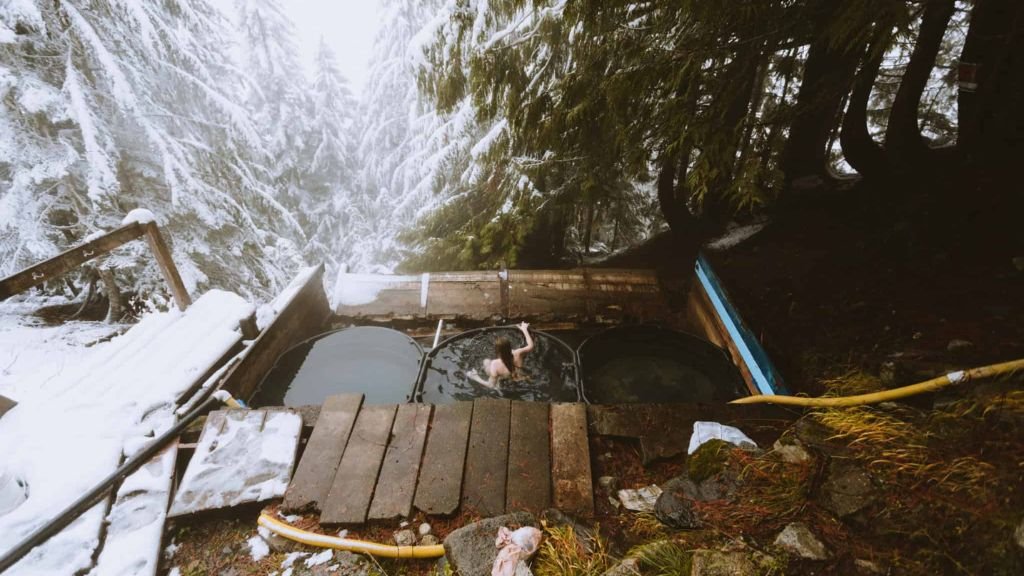
Positioned near Stevens Pass and adjacent to the Alpine Lakes Wilderness, Scenic Hot Springs is a private hot spring site with a rich historical narrative. The area first captured attention during the construction of the Great Northern Railway, leading to the establishment of a resort in the late 19th century. After commercial operations ceased in the early 1920s, the hot springs fell into obscurity until rediscovered by enthusiasts several decades later.
Recent years have seen efforts to reconcile the interests of the public with the preservation of this serene location, leading to controlled public access. Visitation now requires advance permission from the landowner, with a daily cap to maintain the site’s integrity.
For those granted access, it’s an opportunity to contribute to the ongoing legacy of Scenic Hot Springs by respecting the pristine nature of the area and ensuring its viability for future generations.
8. Baker Hot Springs
Baker Hot Springs, nestled in the scenic expanse of the Mt. Baker-Snoqualmie National Forest in Washington, epitomizes the allure of nature’s simplicity. These springs offer a serene soaking experience in pools framed by natural rock walls and a rustic dirt bottom. The springs boast a mesmerizing light blue/green color, with temperatures that fluctuate with the seasons.
Access involves a journey along a 4-mile dirt road that may challenge some vehicles with its rocky stretches. A 4WD vehicle is recommended to navigate this terrain confidently. From the trailhead, a leisurely 5-mile hike leads to the hot springs. This destination welcomes pets and offers a clothing-optional policy for bathers seeking a natural experience. Winter visits are generally discouraged due to road closures from snowfall, though the adventurous can embark on an 8-mile round-trip hike from the main road to access the springs during these colder months.
9. Soap Lake Natural Spa and Resort
Soap Lake Natural Spa and Resort captures the essence of a timeless retreat, grounded in a rich history that traces back to the Native American tribes who once revered these waters for their healing qualities. Soap Lake’s waters are distinguished by a unique mineral makeup, including high concentrations of sulfate, carbonate, bicarbonate, salts, and trace elements, lending the water a soapy texture and buoyancy reminiscent of the Dead Sea.
For centuries, the mineral-rich waters of Soap Lake have been sought after for their therapeutic benefits, believed to relieve conditions such as arthritis and poor circulation. The resort itself radiates rustic charm, with log cabins constructed by skilled local artisans. Guests are treated to a cozy ambiance in rooms that feature private baths filled with naturally healing waters drawn directly from the lake.
Read More: Best Hot Springs in Northern California
10. Sulphur Hot Springs
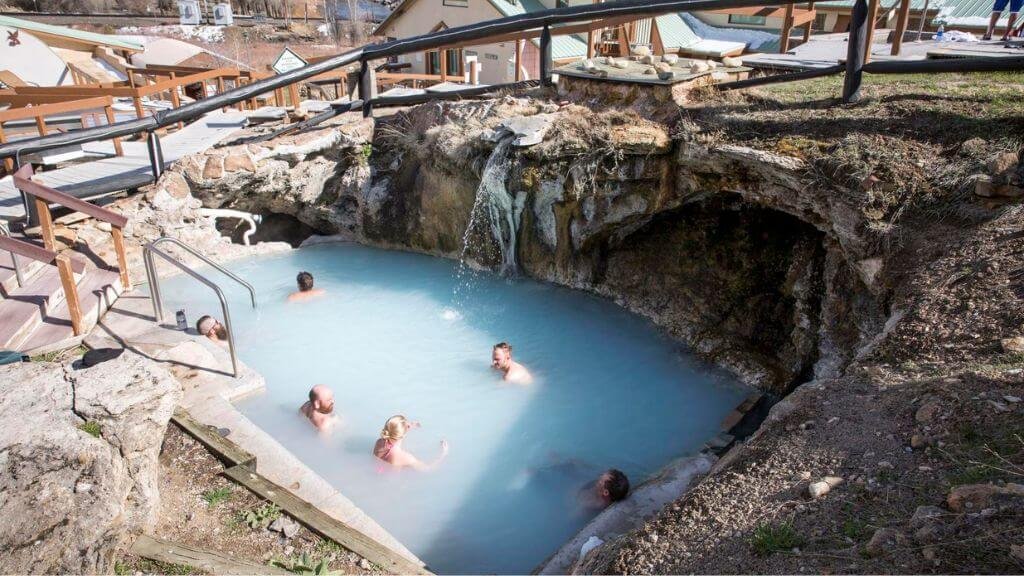
Sulphur Hot Springs is the quintessential escape for those seeking romance or an adventurous family getaway, offering tranquility and intimacy far removed from the hustle and bustle of daily life. The journey to this secluded spring is an adventure in itself, recommended to be undertaken during daylight for the best experience. The path to the spring, following Sulphur Creek, is rustic and less traveled, requiring visitors to navigate through natural obstacles including climbs and tall grass.
The pool at Sulphur Hot Springs, perfect for two, maintains a constant warmth of 90 degrees and is characterized by its distinctive sulfur aroma. It’s likely you’ll find the pool empty upon arrival, but with the simple act of opening the pipe, the pool fills within 20 minutes, transforming into a private oasis ready for relaxation and enjoyment.
Wild vs. Developed Hot Springs
Wild Hot Springs
Wild hot springs, untouched by human construction, offer a pure and intimate experience with nature. These springs are often nestled in remote locations, requiring a journey through stunning landscapes to reach them. The appeal lies in their tranquility and the beauty of their natural surroundings, providing a sense of adventure and connection to the earth that is unmatched.
Developed Hot Springs
Developed hot springs, on the other hand, offer amenities that enhance comfort and accessibility. These facilities may include changing rooms, showers, pools with controlled temperatures, and sometimes even lodging and dining options. For those seeking relaxation without the need for extensive preparation or travel, developed hot springs provide a convenient and comfortable way to enjoy the therapeutic benefits of thermal waters.
The Debate on Preservation vs. Development
The development of hot springs has sparked a debate between the desire for the preservation of natural sites and the demand for accessibility and comfort. While development can make hot springs more accessible to a broader audience, it also risks disturbing delicate ecosystems and the natural beauty of these areas. Balancing conservation efforts with the benefits of development is a challenge that requires careful consideration and planning.
Best Times of Year to Visit Washington Hot Springs
The best time to visit Washington Hot Springs varies by location but generally falls during the shoulder seasons of spring and fall. These times offer milder weather, fewer crowds, and the natural beauty of the changing seasons. Winter visits can be magical, especially at hot springs surrounded by snow, but require extra preparation for cold weather and potential access difficulties.
Tips for a Successful Hot Springs Trip
- Etiquette: Respect the natural environment and other visitors by keeping noise to a minimum, cleaning up after yourself, and following any posted rules.
- Safety: Stay hydrated, monitor your time in the hot water to avoid overheating, and be mindful of slippery surfaces.
- Preparation: Bring essentials like water, snacks, towels, and warm clothing. Check access conditions before you go, especially for wild hot springs that may require hiking or special permissions.
You Can Read: Things to Do in Colorado Springs
Conclusion
Washington hot springs are natural sanctuaries offering more than just warmth and relaxation. They are windows to the state’s rich ecological and cultural tapestry, providing therapeutic benefits against a backdrop of unparalleled beauty. As we seek out these tranquil waters, let us do so with a sense of responsibility and reverence for the land. By exploring responsibly and adhering to conservation principles, we ensure these treasures remain vibrant and accessible for all who seek their comfort and peace. Let the hot springs of Washington inspire a deeper appreciation for nature’s wonders, reminding us of our role in their preservation and the shared joy they bring to our lives.


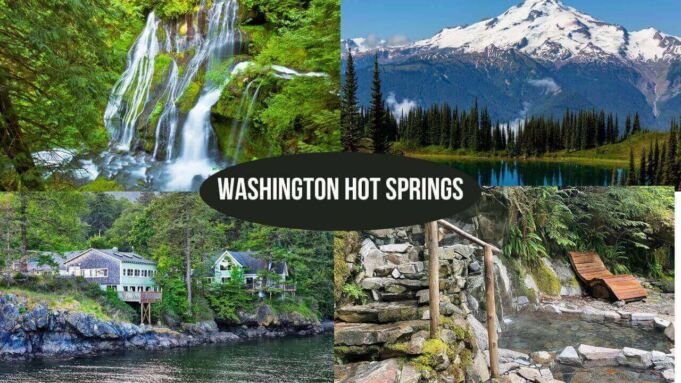
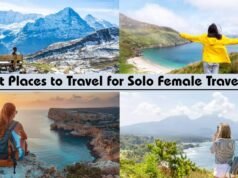
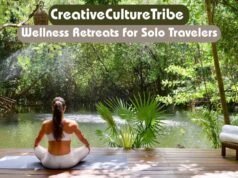
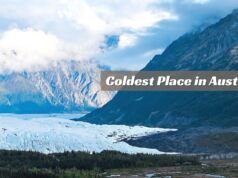










[…] people come to the Smokies during the Spring season as well for the wildflowers that bloom during these months. You can also spot wildlife, as many […]
Comments are closed.